Shock absorber valve fluid dynamic performance is controlled by three easily measured valve port geometric dimensions.
- r.port: Defines the inner radius ware valve port fluid pressure is applied to the shim stack face. The combination of r.port and d.port define the fluid pressure torque deflecting the shim stack
- w.port: Defines the valve port perimeter seat length metering radial outward spill
- d.port: Defines the valve port spoke length metering tangential spill. The d.port seat length progressively opens as the shim stack peels back
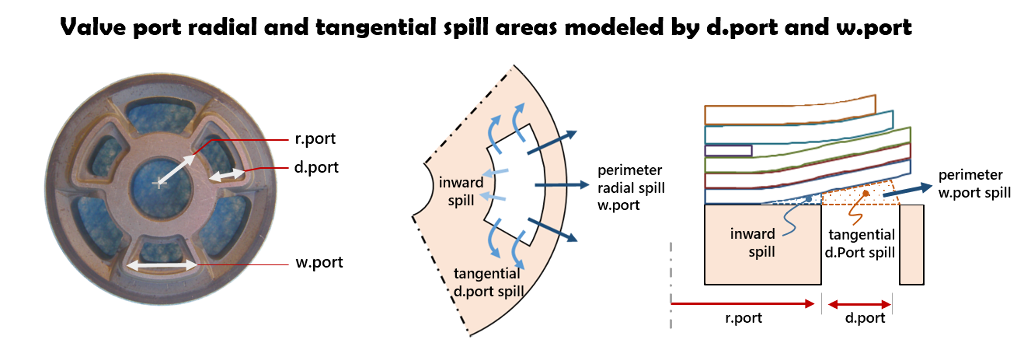
Three easily measured parameters define Shim ReStackor valve port geometry
Additional parameters
Additional parameters: d.thrt defines valve port throat flow restriction; and h.deck defines the port inlet restriction between the valve deck and reverse flow shim stack.
Valves with small deck heights use delta shims to space the reverse flow shim stack above the valve deck. Tuning the inlet restriction controls high speed bottoming resistance.

Valve port throat diameter and deck height describe high speed port restrictions
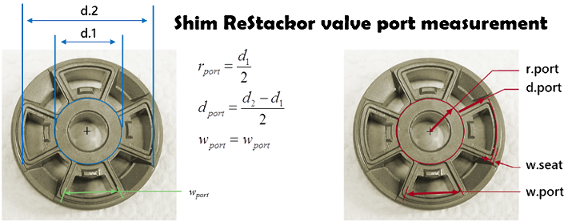
Continuous perimeter seat
For the special case of a continuous perimeter seat, like a compression adjuster valve, the w.port perimeter length is arbitrarily parsed by the number of inlet ports.
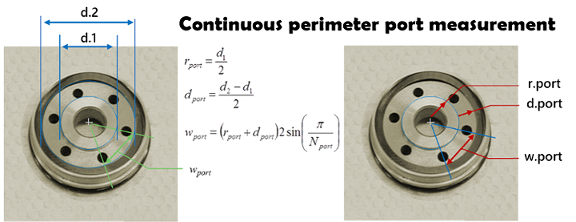
Shock absorber valves generally have sharp port edges making measurements easy. Rounded edges allow fluid pressure to act on the shim stack face up to the location of the seat. The increased pressurized face area increases the fluid force acting on the shim stack increasing the stack deflection.
Measurements of r.port, d.port and w.port need to account for rounded seat edges by measuring the seat-to-seat distance. Likewise, w.port and d.port measure the seat length up to the imaginary intersection of the valve port spoke and perimeter seat, squaring-off the rounded corner.

Valve port dimensions measure seat-to-seat distance to account for rounded edges
Small diameter valve measurement
Enlarged photographs are an easier way to measure port dimensions on small valves. For accurate measurement, the photograph needs to be taken directly over the valve using a camera lens without “fish-eye” effects.
Lens fish-eye can be checked by photographing a piece of graph paper to make sure boxes on the edge of the photograph have the same dimensions as boxes in the center. Changing camera zoom can correct or create fish-eye distortions. Dimensions on the photograph below were measured using “the gimp” and scaled based on the measured outside diameter of the valve.

Small diameter valves measured through photo scaling
Critical performance parameters
Dimensions of r.port, d.port and w.port define the valve port perimeter length, flow area and pressurized face area applying fluid force to the shim stack face.
Shim ReStackor uses those three parameters to define the valve port flow area, A.port. The perimeter spill length, P.spill and the torque based center of fluid pressure cP. Those same parameters have been adopted for modeling in other studies (P. Skackauskas, Vilnius Gediminas Tech Univ, 2016)
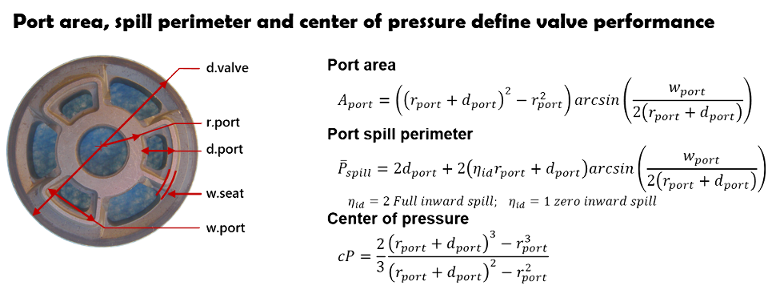
Input parameters r.port, d.port and w.port define the pressurized face area and perimeter spill length
Inward spill is metered by the valve port inside radius r.port and the w.port sweep angle. Inward spill is generally limited by the wedge shaped exit area formed between the valve deck and deflected shim stack. In the above equation the parameter n.id defines the inward spill effectiveness.
A value of two is full inward spill limited only by the port inside perimeter. A n.id value of one gives zero inward spill. The value of n.id is determined internally by Shim ReStackor calculations based on the valve geometry inputs.
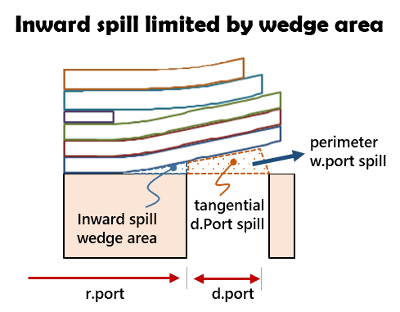
Difficult port geometries
Some shock absorber valves do not have a simple definition of r.port, d.port and w.port. The port flow area and perimeter seat length for those configurations can be estimated through combinations of circles, rectangles and triangles as shown in the example below.
With estimates of port flow area and perimeter length the “effective” dimensions of r.port, d.port and w.port can be determined to match the critical parameters of A.port, P.spill and cP defined in the equations above.
The example below steps through the process.

Values of r.port, d.port and w.port determined for the above geometry do not correspond to any measurable dimension. But, the combination of those parameters match the valve port area, perimeter length and center of pressure.
A simple way to check the accuracy of the deduced dimensions is comparison with damping force measured on a dyno. For the above example, the results provide a close match.
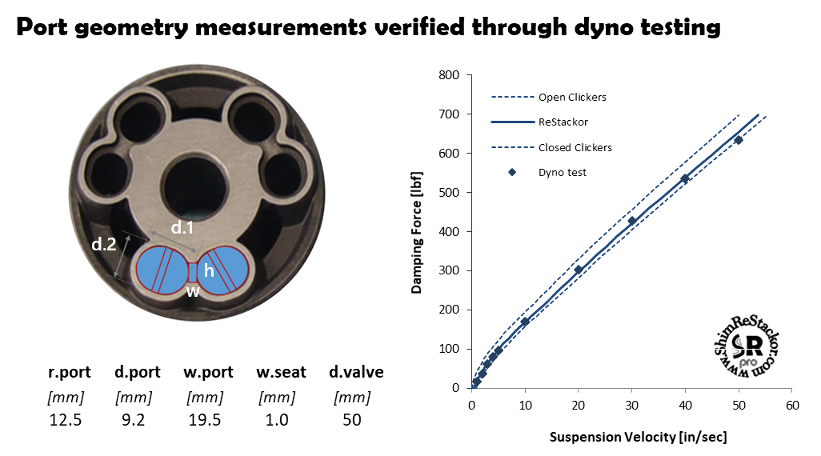
Shock absorber valve port geometry
Shock absorbers use many different styles of valve port ports. Manufacturing convenience dictates some geometries. Others are designed around the use of throat restrictions for control of high speed flows. Regardless of the configuration, three parameters define damping performance:
- Pressurized face area defining the force applied to the shim stack
- Center of pressure defining the torque effectiveness of the applied force
- Valve seat perimeter length metering the fluid flow
The Shim ReStackor input parameters r.port, d.port and w.port define those parameters using simple measurements applicable to a wide range of valve port geometries.
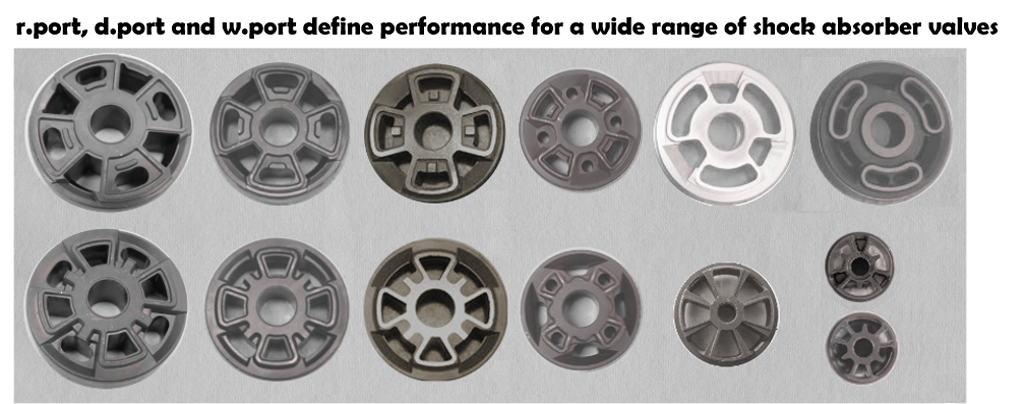
Simple inputs... Thorough analysis... Practical results. Shim ReStackor advances the state of the art in shock absorber performance tuning

